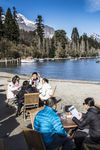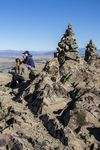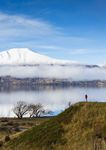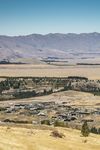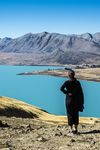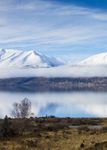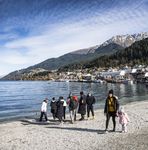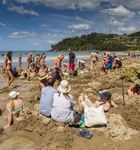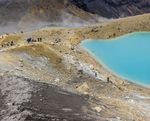TOURISM LANDSCAPE PROTECTION - and - Raewyn Peart and Cordelia Woodhouse - Environmental Defence Society
←
→
Page content transcription
If your browser does not render page correctly, please read the page content below
First published April 2020 Published by: Environmental Defence Society Incorporated P O Box 91736 Victoria St West Auckland 1142 Phone (09) 302 2972 manager@eds.org.nz www.eds.org.nz www.environmentguide.org.nz © Environmental Defence Society Incorporated 2020 Design: Neale Wills, Wilsy Design & Production Ltd Photographic images: Raewyn Peart Cover image: Lake Ōhau Copies can be downloaded from www.eds.org.nz ACKNOWLEDGEMENTS We would like to acknowledge the support of the Ministry of Business, Innovation and Employment and the Tourism Industry New Zealand Trust in funding this case study. We would also like to thank all those who generously agreed to be interviewed for this study and the peer reviewers for their invaluable contributions. This case study will form part of a report being supported by the Department of Conservation and Land Information New Zealand.
TABLE OF CONTENTS
Executive summary 1
1 Introduction 7
2 Tourism and landscape protection 8
PART ONE: INDUSTRY OVERVIEW 9
3 History of tourism in New Zealand 10
4 Current New Zealand tourism industry 12
4.1 Industry profile 12
4.2 Institutional arrangements 13
PART TWO: LANDSCAPE CHALLENGES 17
5 Environmental impacts 18
6 Social impacts 20
7 Infrastructure impacts 24
PART THREE: LANDSCAPE OPPORTUNITIES 25
8 Destination management 26
9 Concessions on the conservation estate 28
10 Tourism levies and charges 31
11 ‘Impact’ tourism 32
12 ‘Slow’ tourism 34
13 Impacts of Covid-19 36
PART FOUR: RECOMMENDATIONS 37
14 Harnessing opportunities 38
14.1 Strengthen institutions 38
14.2 Mainstream destination planning 38
14.3 Create sustainable funding models for infrastructure 39
14.4 Review Conservation Act concession system 39
14.5 Focus government assistance on rebuilding a more resilient tourism sector 39
15 Conclusions 40
References 41
ACRONYMS
DOC Department of Conservation
EDS Environmental Defence Society
MBIE Ministry of Business, Innovation and Employment
NZTA New Zealand Transport Authority
RMA Resource Management Act 1991
RTO Regional Tourism Organisation
TIA Tourism Industry AotearoaEXECUTIVE SUMMARY
Introduction
Aotearoa New Zealand’s distinctive natural landscapes between tourism and landscape protection, including
are an integral component of our individual and national identifying opportunities to develop positive synergies
well-being. But despite their importance, we are still between them. An overall synthesis report for the project
seeing poor landscape outcomes. In order to address this will be released later in 2020.
matter, the Environmental Defence Society (EDS) has
Most of the research for this case study was completed
initiated a project to investigate how existing legislative
prior to the Covid-19 outbreak in March 2020 which has
and policy tools could be more effectively deployed to
had catastrophic consequences for the tourism industry,
protect important natural landscapes, as well as how a
at least in the short term. Our recommendations do
new ‘protected landscapes’ model could be adopted to
their best to factor in the Covid-19 impacts, but this is a
achieve better landscape protection in New Zealand.
rapidly developing situation, and we recommend further
The project includes a number of case studies. This work is undertaken once the situation and opportunities
case study is focused on investigating potential linkages become clearer.
Queenstown
EXECUTIVE SUMMARY 1PART ONE: INDUSTRY OVERVIEW Bay of Islands
History of tourism in New Zealand
New Zealand tourism has its roots in the traditional Māori
practice of manaakitanga or hosting guests which was
extended to manuhiri (visitors) including early European
explorers. Well-to-do British, Australian and American
travellers started visiting New Zealand in ocean-going
steamships during the 1870s. This prompted the
government to become involved in the tourism industry
with the Department of Tourist and Health Resorts
established in 1901.
It took many decades for the international tourism
industry to develop due to New Zealand’s long distance
from major markets, the high cost of travel, and a lack of
interest and investment by the private sector. Government
bought out many failing companies so became a major
tourism operator in its own right. There was a turnaround
in the industry during the 1960s supported by the advent Zealand, New Zealand Māori Tourism, DOC and Tourism
of passenger jets. Wide-bodied jets brought in greater Industry Aotearoa (TIA). Regional Tourism Organisations
numbers of visitors during the 1980s. As the industry (RTOs) operate variously at regional and local levels
became more profitable, government exited from around the country.
commercial involvement in the sector.
At the central government level, MBIE’s tourism unit
The Tourist Department was disbanded in 1990, provides policy advice and commissions around $4.8
leaving in place a smaller policy unit. The New Zealand million of tourism-related data each year. There are several
Tourist Board was established to market New Zealand notable gaps in the information gathered, particularly
overseas. The highly successful brand ‘100% Pure New concerning domestic tourists and the value of landscape
Zealand’ was developed during the early 2000s. The to tourism. Tourism New Zealand is a Crown Entity
Department of Conservation (DOC) was established in established under the New Zealand Tourism Board Act
1987 and given the task of managing visitor activities 1991 with the sole purpose of marketing New Zealand
on public conservation land and waters, along with a overseas, which it has done very successfully. New
wide range of other regulatory responsibilities under the Zealand Māori Tourism supports the large network of
Conservation Act 1987. Māori tourism businesses. DOC is heavily involved in the
tourism industry with public conservation land and waters
Current New Zealand tourism industry
providing a major contribution to the tourism offering in
Until the impact of Covid-19, tourism was New Zealand’s New Zealand. As visitor numbers burgeoned in recent
biggest export earner, contributing 20.4 per cent of years, there has been a noticeable lack of proactive
the country’s foreign exchange earnings. International planning on how to manage such growth at a central
tourists spent $17.2 billion and domestic tourists $23.7 government level.
billion over the past year. There were over 3.9 million
visitor arrivals in New Zealand that year, with the greatest TIA is an industry body representing around 1650
number from Australia (40%), followed by China (10%) businesses and organisations in the tourism sector, which
comprise some 85 per cent of total industry turnover.
and the USA (9%).
TIA is a membership-funded body (unlike primary sector
The tourist industry consists of a large number of small industry bodies which are funded through statutory
businesses, as well as some medium-sized and a few levies), and this has severely limited its budget. Its small
large entities. Prior to Covid-19, over 229,000 people were team focuses on advocacy, communication and strategy.
directly employed in the tourism industry, comprising
There are 31 RTOs located around the country of greatly
8.4 per cent of national employment. Another 164,000
varying structures and sizes. They have mainly focused
were indirectly employed meaning that more than 1 out
on destination marketing rather than management.
of 7 jobs in the country have been supported by tourism.
There is a general lack of economies of scale and
The past two decades has seen a significant increase in
connection between the work of the RTOs and other
Māori investment in tourism, particularly following Treaty
council functions such as infrastructure provision and
settlements, with possibly around 1200 Māori tourism
environmental protection.
enterprises involved in the sector.
The fragmented nature of the tourism industry and
Institutional arrangements its institutional arrangements has been a barrier
Tourism support institutions include, at a national level, to involvement in broader landscape issues. This
the Tourism Policy Unit in the Ministry of Business, fragmentation will need to be addressed promptly in order
Innovation and Employment (MBIE), Tourism New to develop a coherent response to the Covid-19 downturn.
2 TOURISM AND LANDSCAPE PROTECTION EXECUTIVE SUMMARYPART TWO: LANDSCAPE environmental degradation through problems such as
overflowing sewerage systems and waste left along tracks
CHALLENGES and in informal campsites.
Social impacts There have been various government funds established
Tourism can impact small communities by swamping over the years designed to provide assistance to councils
them with people, overloading local infrastructure, in funding infrastructure improvements. However, such
increasing property prices out of the reach of locals and initiatives appear ad hoc and reactive, seeking to address
reducing the availability of housing through conversion of serious problems after they have developed. More
homes to AirBnBs and the like. On the other hand, tourism permanent funding arrangements, accompanied by better
can benefit such communities through providing much planning, might help to avert such crises before they occur.
needed jobs and income.
Environmental impacts
A stronger focus on ‘place’ and the aspirations of the
Tourism can have significant impacts on the environment
community at a local level when planning for tourism
due to the large numbers of people travelling, engaging
could help ensure that landscape values of importance to
in outdoor activities, and being accommodated
local communities are better protected. However, this may
and provisioned. A degraded environment can also
require linking such tourism plans to statutory processes,
significantly impact the tourism industry although there is
such as plans under the Resource Management Act 1991
little quantification of this effect.
(RMA), to give them ‘teeth’.
The downturn in tourism due to the pandemic should
Infrastructure impacts provide some short to medium term relief for the
New Zealand’s rapidly increasing visitor numbers have environment. It also provides the opportunity to rebuild a
outstripped available infrastructure in many areas. more resilient and environmentally-atuned tourism sector
As well as detracting from the visitor experience, a which is able to grow in the future without causing the
lack of adequate tourism infrastructure can result in damaging environmental impacts recently experienced.
Church of Good Shepherd, Tekapō
EXECUTIVE SUMMARY 3PART THREE: LANDSCAPE RMA and conservation management strategies and plans
under the Conservation Act.
OPPORTUNITIES
Concessions on the conservation estate
Destination management
Most commercial activities within conservation land and
Destination management has traditionally been
water require a concession, which are granted under
understood as the coordinated management of the visitor
the Conservation Act. Last year there were around 1100
experience in a specific place including; marketing the
tourism-related concessions managed by DOC and the
area, managing its values and attractions (including
people), and providing suitable visitor access and government generated over $27 million from conservation
infrastructure. The aim is to ensure a quality visitor concessions, leases and licences.
experience and therefore likely repeat visitation. The The recent Ngāi Tai Ki Tāmaki Supreme Court decision,
concept is rapidly evolving and broadening out from interpreting the application of Te Tiriti o Waitangi
purely considering the tourist experience to include the provisions to the grant of concessions, is likely to support
local community and environment. It can include aims greater involvement by iwi and hapū in tourism activities
such as ensuring tourism is community led, enriches the in the conservation estate. However, it has created some
environment and is financially sustainable. uncertainty for the broader tourism industry with expiring
Historically, there has been a strong emphasis in New concessions currently being rolled over for short terms
Zealand on marketing to bring tourists into the country and reviews of park plans being put on hold.
rather than on managing the places that tourists visit. A recent review of Tourism New Zealand and our
Management of destinations at a regional and local level, interviewees from the tourism industry were critical of
if it happens at all, is particularly fragmented with the role the current system. Some suggested DOC should be
undertaken by a variety of entities including territorial more entrepreneurial and facilitate more tourism activity
authorities, RTOs, economic development agencies and
if it is well managed and can contribute significant funds
macro-regional marketing alliances.
to conservation activities. Interviewees also noted that
Destination management planning provides an excellent the concessionaire relationship with DOC was largely
opportunity to identify landscape values of importance to transactional and based on financial matters rather on
mana whenua, visitors and local communities. Landscape exploring opportunities for mutual conservation and
protection measures could be incorporated into statutory business gain. Mechanisms for managing the allocation of
planning by linking them with policies and plans under the limited concession opportunities were also seen as fraught.
Aoraki Mount Cook National Park
4 TOURISM AND LANDSCAPE PROTECTION EXECUTIVE SUMMARYThese comments from the industry reflect the inherent predator control. The challenge is how to scale this activity
tension between the aspirations of the tourism up to a landscape level, and in the post-Covid-19 context,
industry and DOC’s statutory role, which is to manage this will initially need to be on the back of domestic tourism.
conservation land and water in the broader public
interest. The challenge is to design a system that both ‘Slow’ tourism
supports tourism, which is an important industry for Experiences such as cycle trails and wine trails help to
local communities and the nation, and generates positive slow down tourist travel and they facilitate engagement
outcomes for biodiversity and landscapes within the with mana whenua, the local community and businesses
broader conservation management system. such as on-farm accommodation and local cafes. A
focus on promoting ‘slow’ tourism, including developing
Tourism levies and charges experiences where tourists have a deeper engagement
A range of tourism charges have been developed over with New Zealand’s landscapes, Māori cultural
recent years, including the accommodation provider associations with them and local communities which
targeted rate in Auckland and the International Visitor derive a livelihood from them, could help draw a closer
Conservation and Tourism Levy which came into force linkage between tourism and landscape protection.
in July 2019. The latter was particularly promising as it
generated considerable funds (estimated to be $450 Impacts of Covid-19
million over 5 years) for both conservation as well as At the time of writing, New Zealand is in level-3 lockdown
tourism provision. It therefore provided a very tangible with the borders closed to all visitors except returning
mechanism for tourism to support biodiversity and New Zealanders. The tourism industry in New Zealand
landscape protection. But with the current closure of the has ground to a halt. This is a fast-changing situation.
borders, and likely paucity of international visitors over the The border seems likely to remain closed to international
next few years, the funds raised through this mechanism travellers until after a vaccine for Covid-19 is available
are likely to be negligible over the short to medium term. in 12 to 18 months’ time. However international tourism
may take much longer to recover, possibly up to five
‘Impact’ tourism years or more, due to a likely global recession and fewer
‘Impact’ tourism, is tourism which provides both economic planes flying internationally. As a result, any short-term
and environmental benefits to the locality within which revival of the tourism industry will need to be based
it takes place. Many New Zealand tourism operators on the domestic market. Overall, Covid-19 will have a
are already seeking to directly contribute to biodiversity devastating effect on New Zealand’s tourism industry, but
protection through funding or involving tourists directly it also provides the opportunity for a reset in the way the
in actions such as replanting indigenous vegetation and industry operates.
Alps2Ocean Cycleway
EXECUTIVE SUMMARY 5PART FOUR: RECOMMENDATIONS ■ Linking such plans with regional and district plans
under the RMA
Harnessing opportunities
■ Linking such plans with conservation management
Covid-19 has changed everything for the tourism strategies and plans under the Conservation Act
industry. New Zealand’s economy will never be the
same. Businesses will need to be more resilient. To 3. Create sustainable funding models for infrastructure
flourish in the long-term, and minimise future shocks, through:
they will need to be environmentally and climate ■ Putting in place a fairer and more sustainable
friendly. Government is also likely to have much more funding model before any future tourism boom
involvement in the economy. A massive infrastructure
renewal programme is in prospect to put jobless ■ Ensuring any funding is linked to close scrutiny
people into work, the ambit of which could also include to ensure infrastructure is well designed and
conservation projects. Government is developing a carefully located to minimise landscape and other
plan to restart the tourism industry which will focus environmental impacts
on promoting domestic tourism. It is possible that 4 Review Conservation Act concession system through:
Government will become a co-investor in key sectors of
the tourism industry as has happened in the past. ■ Undertaking a first principles review to ensure that
the system works well for conservation, recreation,
Change creates risk but also opportunity. A ‘restarted’ Maori, and for tourism
tourism industry could have a different focus, an emphasis
on value over volume, and stronger links with the 5. Focus government assistance on rebuilding a more
landscape, nature, Māori culture and local communities in resilient tourism sector through:
a meaningful way. The relationship between the industry ■ Building value rather than volume
and the public conservation estate could be reorientated
■ Reducing greenhouse gas emissions
towards a deeper ‘friendship’ with mutual obligations
as well as benefits. The industry could become more ■ Supporting ‘slow’ tourism to provide more authentic
diverse to help build in resilience and we could start to ways for tourists to engage with landscapes, and
develop positive synergies between tourism and the mana whenua and communities that live and work
landscapes and communities that support it. Our specific within them
recommendations on how a stronger link could be built
■ Fully offsetting international visitor air miles through
between the tourism industry and landscape protection
a programme of replanting indigenous vegetation
are as follows:
1. Strengthen institutions through:
Conclusions
■ Boosting tourism capacity within MBIE or
establishing a separate Ministry for Tourism New Zealand’s distinctive natural landscapes are an
integral part of our national identity and they are at the
■ Increasing the resources of New Zealand Māori heart of the tourism industry. Tourism can have negative
Tourism impacts on natural landscapes and the environment more
■ Developing a future sustainable funding model for generally. But there is also considerable opportunity for
TIA tourism to be a positive contributor to conservation and
landscape protection. This report has identified a range
■ Bringing together and better supporting RTOs either of areas where this could be progressed. The industry is
through rationalisation or building strategic alliances already moving in this direction but would benefit from
2. Mainstream destination planning through: improved institutions, data and support to help achieve
it. The Covid-19 pandemic provides an opportunity to
■ Adopting a broad scope for destination planning rebuild a tourism industry that is more resilient, has a
including managing the impacts of tourism on local lighter environmental footprint, and provides authentic
communities and the environment experiences that more fully engage with New Zealand’s
■ Resourcing and incentivising the preparation of extraordinary landscapes.
destination management plans
6 TOURISM AND LANDSCAPE PROTECTION EXECUTIVE SUMMARY1. INTRODUCTION
Aotearoa New Zealand’s distinctive natural landscapes are of this case study. All the case studies will be integrated
an integral component of our individual and national well- into an overall synthesis report, which will also contain
being. For Māori, they provide a deep cultural connection a broader exploration of the concept of landscape in the
with the past and future through whakapapa. Landscapes New Zealand context, to be released later in 2020.
provide physical and spiritual respite, historical links and
The research for this case study was completed prior
havens for biodiversity. They are a source for creative
to the Covid-19 outbreak in March 2020. This has had
endeavour, a key component of the New Zealand brand,
catastrophic consequences for the tourism industry in
and have been a major drawcard to date for burgeoning
New Zealand, at least in the short term. This case study
international tourist numbers.
reports on what we found in the context of a flourishing
Despite the importance of landscapes to New Zealand, tourism industry prior to the pandemic.
we are still seeing poor landscape outcomes. In order to
We have included a brief section that provides some initial
address this matter, the Environmental Defence Society
thoughts on what the implications of Covid-19 may be for
(EDS) has initiated a project to investigate how existing
the tourism industry. However, it is still early days for what
legislative and policy tools could be more effectively
is a very fast developing situation and it remains unclear
deployed to protect important natural landscapes, as
to what extent travel around New Zealand will be possible
well as how a new ‘protected landscapes’ model could
in the near term and when New Zealand’s borders will
be adopted to achieve better landscape protection in
open to international visitors. Our recommendations do
New Zealand.
their best in this context to factor in the Covid-19 impacts
The project involves case studies of landscape protection and look to identify opportunities for strengthening the
in Te Manahuna – Mackenzie Basin, Banks Peninsula, link between tourism and landscape protection during the
Waitakere Ranges and the Hauraki Gulf Islands. It also post-Covid-19 economic reconstruction process. But we
includes an investigation of potential linkages between would recommend further work is undertaken in this area
tourism and landscape protection which is the subject once the situation and opportunities becomes clearer.
Mackenzie Basin
INTRODUCTION 72. TOURISM AND LANDSCAPE PROTECTION
“If we look at NZ tourism and its of natural heritage values, gaining public support for its
protection and contributing to the resources needed to
relationship with our landscape, the two achieve it. The challenge New Zealand faces is to develop
are linked in a way few other countries positive synergies between tourism and landscape
can claim. Our attractions, almost without protection so that they strengthen each other. 3 Identifying
opportunities to achieve this is the focus of this case study.
exception, are our landscapes.” 1
The case study is, first, based on a review of the available
literature. Overall, we found that there is a paucity of
written material on the linkage between tourism and
“People come to New Zealand mainly landscape protection. The small amount of available
because of our natural landscapes. Many material was supplemented by interviews with 22 key
visitors want and expect to see us taking informants and a small group meeting of tourism-related
people in Wanaka. The interviews were undertaken
good care of those landscapes and a on a confidential basis to encourage frankness. We
subset care about the protection of our have included some quotes from these interviews to
unique biodiversity.”2 provide ‘colour’ to the analysis below, however, we
have not identified the source in order to maintain the
confidentiality of the respondent. Some quotes are from
In the current New Zealand context, tourism and published sources and where this is the case, we have
landscape are inextricably linked. The tourism industry footnoted the reference.
benefits from outstanding natural landscapes and a The report is structured into three main parts. Part
healthy natural environment which can be a major draw One provides an overview of the tourism industry, Part
for tourists. But at the same time tourism can negatively Two explores current tourism challenges of relevance
impact on these attractions. This occurs, for example, to landscape protection, and Part Three explores
when tourist infrastructure and accommodation is built opportunities to draw a closer link between tourism and
on visually prominent sites such as lakesides, sensitive landscape protection. The report concludes with a set of
sites are trampled and tourists leave waste behind. recommendations as to how these opportunities could be
Well-managed tourism can, in turn, benefit landscapes further explored and developed.
and biodiversity values through improving understanding
Moeraki
8 TOURISM AND LANDSCAPE PROTECTIONPART ONE: INDUSTRY OVERVIEW
Lake Tekapō
PART ONE: INDUSTRY OVERVIEW 93. HISTORY OF TOURISM IN NEW ZEALAND
New Zealand tourism has its roots in the traditional The arrival of these visitors prompted the government
Māori practice of manaakitanga, or hosting guests, to become involved in the tourism industry in order to
which was extended to manuhiri (visitors) including foster its growth. Initial attention was focused on Rotorua,
early European explorers. “Manaakitanga is a reciprocal which was seen as having potential as a spa town due
practice that demonstrates peoples’ mana (prestige and to its thermal activity. Instead of partnering with Māori
authority) and capacity to look after and enhance the to develop the industry, the government set about taking
mana of others. During pōwhiri (welcome ceremonies), sole control of the thermal area. Facilitated by the passage
tangata whenua display manaakitanga by putting on a of the Thermal-Springs Districts Act 1881, government
hākari (feast) for their manuhiri and providing hospitality obtained title to around 2000 hectares of Māori land on
such as accommodation.”4 the shores of Lake Rotorua; land which included all of the
best hot springs.6
Just three decades after the signing of Te Tiriti o Waitangi
in 1840, well-to-do British, Australian and American As the tourism industry developed, Māori culture was
travellers started visiting New Zealand in ocean-going treated as something to be “packaged and marketed as an
steamships. They were coming to view the country’s exotic ‘other’”.7 Daily Māori life in Whakarewarewa village
spectacular mountains, forests, lakes and geysers as well was exploited as an attraction for tourists, a model pā was
as to experience the unique Māori culture. Popular areas established in Rotorua during the 1900s, and portraits of
included Milford Sound, the Whanganui River and Rotorua traditional Māori life and attractive Māori women were
which at the time featured the spectacular Pink and White commonly used for tourist postcards. 8
Terraces (later destroyed in the 1886 Mount Tarawera
New Zealand’s first national tourism office was
eruption). These early tourists were hosted and guided by
established in 1901 in the form of the Department of
both Māori and Pākeha.5
Milford Sound
10 TOURISM AND LANDSCAPE PROTECTIONTourist and Health Resorts. It is thought to be the first Zealand Historic Places Trust).13 Under the Conservation
government tourism department in the world. The Act 1987, which established the department, its functions
Department undertook a wide range of tourism activities included; managing public conservation land, advocating
including acting as a travel wholesaler, retail travel for the conservation of natural and historic resources and
agent and coach tour operator, and providing a visitor fostering “the use of natural and historic resources for
information office. This early involvement of government recreation, and to allow for their use for tourism” to the
in the industry led to tourism income being diverted away extent this was not inconsistent with its conservation.14
from Māori who were also excluded from areas later Therefore, DOC has always operated at the often difficult
developed as tourist attractions including national parks.9 intersection between conservation and tourism. The
Department has done much to support the tourism
The earliest data on tourist numbers is for 1903 when 5233
industry, including developing a network of ‘Great Walks’
international visitors were recorded. It took many decades
in 1993, and forming a partnership with Air New Zealand
for the international tourism industry to develop due to in 2012 to market them to travellors. As part of this
New Zealand’s long distance from major markets, the high initiative Air New Zealand agreed to financially support
cost of travel and a lack of interest and investment by the DOC’s conservation initiatives.15
private sector. Where there was investment, it often proved
to be unprofitable. This led to the government buy out of The privatisation of the tourism sector led to the
many failing companies including the Hermitage Hotel at government disbanding the Tourist Department in 1990,
Mount Cook, the Chateau in Tongariro National Park and leaving in place a smaller policy unit (the Ministry of
steamers on Lake Wakatipu. The Tourist Hotel Corporation Tourism, later merged into the Ministry of Business,
was established in 1955 to expand the network of Innovation and Employment (MBIE)). Government
government-owned hotels.10 funnelled most of its public tourism funding into the
New Zealand Tourist Board (later renamed Tourism New
There was a turnaround in the industry during the Zealand) in order to market the country overseas. The
1960s, supported by the advent of passenger jets, when brand ‘100% Pure New Zealand’ was developed during
tourist numbers started to rapidly grow. Legislation the early 2000s, designed to align with images of New
established the Māori Arts and Crafts Institute in 1963 to Zealand’s spectacular landscapes. The first of the Lord
help preserve traditional carving skills and produce high of the Rings movie trilogy was released in 2001, and this
quality souvenirs for international tourists. The Auckland profiled a backdrop of stunning New Zealand landscapes,
International Airport at Mangere was officially opened in helping to further increase the country’s appeal. By 2008,
1966. To address an accommodation shortage for visitors, the combined annual spending of international and
the government provided financial assistance to the domestic tourists had reached $20 billion.16
private sector for the construction of more hotels, followed
by support for the establishment of tourist activities such
as the Agrodome in Rotorua.11
Wide-bodied jets brought in greater numbers of visitors
during the 1980s. By 1985 annual international tourism
numbers had reached half a million. The industry
became more profitable and the government exited
from active involvement in the sector, selling its hotels.
Adventure tourism became established with bungy
jumping from the Kawerau River bridge in Queenstown
commencing in 1988. 12
There has been a long history of nature-based tourism
in New Zealand and it has a strong association with
the country’s growing environmental movement. One
example is Les and Olive Hutchings who started offering
tours on Lake Manapouri and into Doubtful Sound during
the 1950s. The couple were involved in the successful
Save the Manapouri campaign between 1969 and 1972
which stopped the raising of Lake Manapouri for power
generation and ignited the environmental awareness of
many New Zealanders. The growth of marine mammal-
based tourism was led by Whale Watch Kaikōura which
began operating in 1987.
The Department of Conservation (DOC) was established
in 1987, with staff members drawn from the former New
Zealand Forest Service, Department of Lands and Survey
and the Department of Internal Affairs (including the
Doubtful Sound
Widlife Service and Archaeology Section of the New
3. HISTORY OF TOURISM IN NEW ZEALAND 114. CURRENT NEW ZEALAND TOURISM INDUSTRY
4.1 Industry profile It is difficult to obtain information on the characteristics of
businesses operating within the tourism industry itself, as
Until the impact of Covid-19, tourism was New Zealand’s such data is not collected by Statistics New Zealand. This
biggest export earner, contributing 20.4 per cent of the seems initially surprising, given the economic importance
country’s foreign exchange earnings in the year ended of the sector to the country, but reflects the considerable
March 2019. Interestingly, 2019 survey data indicated that difficulty in identifying what exactly a tourism business
only 12 per cent of New Zealanders were aware of tourism’s is. Supermarkets and fuel stations in popular tourism
status as the country’s number one export industry.17 towns such as Queenstown, Wanaka and Twizel derive
International tourists spent $17.2 billion and domestic much of their income from tourists but would not normally
tourists $23.7 billion during that year.18 This included be considered tourism businesses. The more directly
$3.8 billion in GST, with $1.8 billion of this collected from tourist-related industry consists of a large number of
international visitors.19 This payment of GST means that small businesses as well as some medium-sized and a
tourism is treated differently to other export sectors in few large entities. Travel agents still play a large role in the
New Zealand which can sell their goods and services to sector, with around 70 per cent of Chinese and American
overseas customers without any GST being charged. 20 and 50 per cent of Australian visitors using travel agents
There were over 3.9 million visitor arrivals in New Zealand to book their holidays in New Zealand. 25 We were told by
for the year ended December 2019. The greatest number interviewees that there has been some aggregation of the
were from Australia (40%), followed by China (10%) sector during recent years.
and the USA (9%). In terms of regional tourism spend, Prior to Covid-19, over 229,000 people were directly
Auckland was by far the largest recipient (28% of the employed in the tourism industry, comprising 8.4 per cent
total), followed by Canterbury and Otago with 14 per of national employment. 26 Another 164,000 were indirectly
cent each. Such arrivals included cruise ship passengers, employed, meaning that more than 1 out of 7 jobs in the
which totalled 222,000 in the year ended June 2017, with country have been supported by tourism. 27
half of these being from Australia. 21 It should be noted that
just under 2 million of the 2019 international visitors (50%) The past two decades has also seen a significant increase
were holidaymakers, 27 per cent were visiting friends in Māori investment in tourism, particularly following
and relatives, 11 per cent were here on business or for Treaty settlements, with possibly around 1200 Māori
conferences and 2 per cent to study. 22 tourism enterprises currently operating. 28 Tourism offers
iwi an opportunity to diversify investment away from
There was a 35 per cent growth in visitor arrivals from the primary sector and to create job opportunities for
2014-2018, but only a 0.7 per cent growth in 2019. 23 young Māori. Many businesses now interweave Māori
Forecasts from early 2019 put the number of visitors cultural elements throughout their operations, rather than
arriving into New Zealand in 2025 at 5.1 million based on a only directly showcasing Māori culture through cultural
4 per cent increase each year. 24 However, these forecasts performances and the like.
were undertaken prior to the slowdown in arrivals in 2019
and prior to Covid-19. The impact of the pandemic is likely There has also been a move towards iwi co-investment
to significantly reduce international travel into the future. with other partners with, for example, Ngāti Tuwharetoa
Wanaka
12 TOURISM AND LANDSCAPE PROTECTIONrecently co-investing in the $25 million Sky Waka Gondola undertaken from 1999 but was discontinued in 2012
on Mount Ruapehu. Ngāi Tahu Tourism is now one due to concerns about high cost and low data quality.33
of the largest tourism operators in New Zealand with The Accommodation Survey, which was undertaken by
investments in a broad range of activities including the Statistics New Zealand under commission from MBIE
Agrodome, Rainbow Springs and Huka falls jet in the for many years, was discontinued in October 2019 on the
North Island, and Tekapō’s Earth and Sky, glacier trips, basis that “Stats NZ is under significant cost pressures and
walks, snowmobiles, jet boats and helicopter flights in the is no longer able to run them based on present funding.”34
South Island. 29 Iwi have also formed partnerships with The survey collected information on guest nights in hotels,
DOC for conservation initiatives including predator control motels, backpackers and holiday parks which was broken
projects in Te Manahuna Aoraki and Taranaki Mounga. down by region. However it did not include a range of
overnight accommodation options including Bookabach,
Overall, the tourism industry has been a significant
AirBnb providers, bed and breakfast accommodation,
contributor to New Zealand’s foreign exchange, jobs
cruise ships, tramping huts and freedom camping, so was
and incomes. It has provided diversified investment
unable to provide the full picture.35 There is no survey of
opportunities for Māori and fuelled regional economies. It
tourism providers. Overall, much remains unknown about
is an important industry for the country.
tourists and the tourism industry in New Zealand.
There is also a paucity of information about the value of
4.2 Institutional arrangements landscape to tourism. Some information on this topic can
Institutional arrangements for tourism are of relevance be gleaned from the International Visitor Survey data
to this case study as they provide a structure through on visitor preferences and also records of the number of
which positive initiatives within the industry might be people visiting public conservation land, but there is little
incentivised and supported. They include, at a central else. Such information would be valuable in informing
level, the Tourism Policy Unit in MBIE, Tourism New choices about land use which may impact on landscape
Zealand, New Zealand Māori Tourism, DOC and Tourism values of importance to the tourism industry.
Industry Aotearoa (TIA). Regional Tourism Organisations
(RTOs) operate variously at regional and local levels
around the country. “No-one does decent analysis into tourism.”
The small Tourism Policy Unit within MBIE provides policy
advice to the Minister of Tourism, works on key tourism
policy issues and undertakes monitoring of the operations “The previous government tended to chip
of Tourism New Zealand. Staffing numbers have recently away at budgets so things got smaller. The
been increased to 50 from only around 15 staff dedicated
to tourism matters within MBIE two years ago.30 The Unit [tourism data] system is heavily degraded
oversaw, in partnership with DOC, the development of compared to what we had in the past.”
the government’s 2019 Tourism Strategy which identified
five outcomes for the industry focused on; the economy,
the environment, the visitor experience, New Zealanders The adequacy of current tourism data was questioned
and their communities, and regions . 31 Although New by several of our interviewees. In addition, the recent
Zealand’s natural landscapes are well recognised as the review of Tourism New Zealand identified the absence of
main draw for international tourists, and feature strongly systematic information on the preferences of domestic
as part of the 100% Pure marketing campaigns run by visitors as a notable gap.36 This gap is likely to become
Tourism New Zealand, the word ‘landscape’ does not more significant as the industry focuses on domestic
receive a specific mention in the Strategy, nor the need to tourists during a staged recovery or reconfiguration
protect landscapes to strengthen the tourism sector long post-Covid-19. Such concerns led MBIE to convene a
term (although such matters could be implied in the more Tourism Data Hui in October 2019 to discuss the industry’s
general discussion about restoring and protecting the future information needs. With the current changed
natural environment). circumstances, the data needs of the industry may now
need to be reassessed.
The Tourism Policy Unit also commissions research
and the collection of tourism statistics. It currently Tourism New Zealand is a Crown Entity established
commissions around $4.8 million worth of data each year, under the New Zealand Tourism Board Act 1991. It has
including the International Visitor Survey, regional tourism around 150 staff based in 13 offices around the world and
estimates based on monthly credit card and eftpos data, a budget of $111.5 million.37 Its sole purpose is to market
a tourism satellite account prepared by Statistics New New Zealand overseas as a tourist destination and it
Zealand, and forecasts of international tourist numbers has been highly successful in this role. 38 For the past 20
and expenditure.32 years, this marketing has focused on the 100% Pure New
Zealand marketing campaign.
There are many notable gaps in the information currently
gathered. For example, there is no domestic visitor New Zealand Māori Tourism, which was established in
survey, despite domestic tourism being a larger sector 2005 and is primarily funded by Te Puni Kōkiri, supports
than international. A Domestic Travel Survey was a large network of Māori tourism businesses. It advocates
4. CURRENT NEW ZEALAND TOURISM INDUSTRY 13for Māori tourism within government and supports and $25 million being spent on agricultural policy advice
Māori tourism aspirations. This includes finding potential by the Ministry for Primary Industries (MPI) each year.41
commercial partners for Māori tourism investments.
We also received some comment on the need for central
DOC is heavily involved in the tourism industry with the government to be better aligned on tourism matters,
conservation estate providing a major contribution to the with there currently being poor alignment between
tourism offering in New Zealand. An analysis of trends MBIE, Tourism NZ, DOC and the New Zealand Transport
for the year ending June 2017 identified that 53 per cent Agency (NZTA) which provides much of the funding for
of international visitors recorded visits to national parks transportation used by tourists along with others. Better
(totalling 1.7 million visitors) and the annual growth rate
alignment is now being achieved in some inter-agency
since 2014 had been 11 per cent. In addition, around
initiatives such as the Milford Opportunities Project
40 per cent of adult New Zealanders also visit national
described below.
parks (totalling around 1.2 million people).39 As well as
managing visitors, DOC maintains or allows tourism
infrastructure on public conservation land and waters. It
also controls commercial tourism access to these areas
“Tourism is now the number one foreign
through the conservation planning and concessions exchange earner but there is a team of 50
system which operates under the Conservation Act in MBIE versus more than 3000 at MPI.”
1987. Visitor management is only a small part of what
DOC does. The Department has a wide range of
regulatory roles under the Conservation Act, Resource
Management Act (RMA) and a raft of other legislation. “Roading to Tauranga is built for getting
It has long been acknowledged that DOC has been goods to port rather than for travelling
severely underfunded for the size of the task it has
been given. Despite this, the Department has had many
tourists even though two Chinese visitors
conservation successes and has managed to build up a in a rental car equals a logging truck in
network of recreational facilities on public conservation economic value. So where are the passing
land which is “world class”.40
lanes for cars and pull offs so they can
Some interviewees identified an institutional gap for
tourism planning which emerged when the earlier
take good photos?”
Tourist and Publicity Department was disestablished and
government effort refocused primarily on international
TIA is an industry body representing around 1650
marketing through Tourism New Zealand. This gap has
businesses and organisations in the tourism sector, which
become more evident in recent times, with a noticeable
comprise some 85 per cent of total industry turnover.42
lack of planning for how to cope with burgeoning visitor
numbers, leading to overloaded infrastructure and visitor There are also numerous other smaller sub-sector
attractions in some areas. Other interviewees observed organisations such as the Bed and Breakfast Association,
that tourism does not have the same institutional the Holiday Parks Association, the Tourism Export Council
or political heft as the primary sectors. Government (for inbound tour operators) and the Mountain Guides
investment in policy advice between the sectors is Association.43 TIA is a membership-funded body with
instructive in this regard. MBIE invests around $3 million in membership fees totalling $1.7 million in 2018/19. It also
tourism policy advice each year which can be compared raises some funds from events, sponsorship, project funding
to around $11 million being spent on fisheries policy advice and the like to bring the total up to around $3.8 million.44
Aoraki Mount Cook National Park
14 TOURISM AND LANDSCAPE PROTECTIONUnlike primary sector bodies, which are commonly centres which provide destination information as well as
funded through statutory levies on commodities, there is providing booking facilities and selling travel. Some are
no similar funding mechanism for the tourism industry. operated by RTOs, others by councils, and yet others by
This means that funding of the industry body (TIA) is independent operators.49 There is also a network of 19
limited, and its activities mainly focus on advocacy, DOC visitor centres.
communication and strategy. In contrast, DairyNZ is
funded through a statutory levy on milk solids, which Some commentators have expressed disquiet about the
totalled $67.8 million in 2018/19, much of which is spent on rather messy institutional arrangements for the tourism
research and development as well as advocacy. DairyNZ sector at the sub-national level. Albrecht (2017) notes that
directly employs scientists who undertake applied the high number of RTOs, and great disparities between
research and carry out on-farm trials.45 TIA does not have them, has caused a range of problems. RTOs’ “have been
the resources to fund research or support innovation. In slow to keep up with the rapid change in the industry
addition, the tourism sector has not traditionally received and markets”. Regions are “fiercely parochial” and there
significant amounts of government funding for research has been historical rivalry between them. This, combined
and development. with personality issues between tourism managers in
some cases, has complicated cross-RTO collaboration.
There has also been poor connection between RTOs and
“The international visitor levy is the national level tourism initiatives.50
nearest thing we have to an industry levy,
In an article published by The Spinoff, Newport (2017)
the government is levying our customers, notes that “There’s a strong argument to be made that
but none of the money went to TIA.” the free market model of allowing RTOs and the powerful
tourism operators to compete for tourists is producing
an unhealthy, unbalanced tourism landscape. The
Institutional arrangements for the tourism industry at the visitors basically go to the places which shout loudest.”51
regional and local levels is particularly fragmented. There
Pike and Ives (2018) note that most RTOs only have
is a network of 31 RTOs around the country, with these
control over one element of the “4Ps” of the marketing
entities largely focusing on marketing regional and local
mix – promotion. The other three – product development,
destinations. A network of Māori RTOs was created in
pricing and product distribution are generally outside
2001 and these are supported by the New Zealand Māori
Tourism Council. their remit and this limits the ability of RTOs to be
effective. However, some more entrepreneurial
The structure of RTOs varies widely. Some are located RTOs have helped develop new attractions, such as
within territorial authorities as part of economic Tourism Waitaki’s involvement in the establishment
or community services (eg Rotorua and Central
of the Alps2Ocean cycle trail. There has also been a
Otago). Others are established as Council Controlled
repackaging of existing attractions, such as that RTO’s
Organisations so sit at arms-length from council (eg
promotion of the Geopark concept.
Positively Wellington Tourism, Tourism Dunedin and
Destination Great Lakes Taupo). Others are independent
not-for-profit entities (eg Tourism Bay of Plenty which is Queenstown
a trust and Destination Queenstown and Lake Wanaka
Tourism which are incorporated societies).46 Some operate
region wide, through alliances between several councils
(eg Hamilton & Waikato Tourism which is a private-
public partnership funded by seven councils). Some
districts don’t play any active role in tourist marketing (eg
Mackenzie District Council which outsources this role
to Christchurch & Canterbury Tourism). Some councils
have combined their RTOs with broader economic
development agencies (eg Auckland Tourism, Events and
Economic Development which is a Council Controlled
Organisation).47 Some RTOs are funded in part or full
by their local council and others by an annual levy or
membership fee. However, nationwide the bulk of the
funding for RTOs (83 per cent) is sourced from local
government grants.48 There are pros and cons to the
various structures adopted around the country and this
wide diversity in models indicates the different needs and
preferences of the various destinations.
Sitting alongside RTOs is a nationwide network of over
80 i-SITES. These are accredited visitor information
4. CURRENT NEW ZEALAND TOURISM INDUSTRY 15What has generally been missing, however, is a focus people) thereby restricting their capability to be effective,
on the protection of values that draw tourists to an area, although there have been some regional collaborations.53
which in many cases is their natural landscapes. Pike and In addition, the focus of RTOs is largely on destination
Ives also express disquiet about the trend to merge RTOs ‘marketing’ as opposed to destination ‘management’,
into local economic development agencies which can although this is gradually changing. We were advised
lead to a lack of focus on tourism and tourism destination by one interviewee that some RTOs are now starting
marketing relative to the interests of other economic to take a more strategic view of their destinations, and
sectors. There is also a general lack of connection between are starting to think about what the environment will be
the work of the RTOs and other council functions such as like for visitors in 20, 50 or 100 years’ time. However, we
infrastructure provision and environmental protection. were also told that RTOs are particularly poorly served
by the limited tourism information currently available at a
sub-national level.
“While often funded by local government, The fragmented nature of the tourism industry and its
RTOs sometimes have only limited input institutional arrangements has been a barrier to the
sector’s involvement in broader landscape issues. Most
into wider local government decision-
tourism businesses are too small to have the resources
making processes regarding tourism- to get involved in statutory matters like district plans
related infrastructure.”52 in order to protect landscape values of importance to
tourists. TIA also lacks the resources to do this, as do
the numerous and widely scattered RTOs. The Tourism
A recent review of Tourism New Zealand has also Policy Unit in MBIE has limited capacity, although this
identified some issues with the current structure of RTOs. was recently beefed up. DOC is a large institution, but it
The reviewers noted that RTOs are largely based on local has a wide range of functions outside tourism including
government boundaries but these typically do not align managing around a third of New Zealand’s land area. This
with major tourism destinations or tourist itineraries which fragmentation will need to be addressed promptly in order
frequently cross such boundaries. In addition, many of the to develop a coherent response to the Covid-19 downturn.
RTOs are small (sometimes comprising only two or three
Tongariro Crossing
16 TOURISM AND LANDSCAPE PROTECTIONPART TWO: LANDSCAPE CHALLENGES
Tekapō
PART TWO: LANDSCAPE CHALLENGES 175. ENVIRONMENTAL IMPACTS
“Tourism, if done properly, generally has were factored in) if the environmental perceptions of
tourists worsened. 56
a light environmental footprint when
New Zealand is a long-haul destination so, along with
compared to the impacts of extractive
Covid-19, climate issues may have a negative effect on
industries and farming. It’s not perfect, tourism numbers in the future. If the greenhouse gas
but done well, tourism can protect and emissions generated by long haul flying are no longer
seen as socially acceptable this may result in ‘climate
enhance the environment not damage it.”
shaming’ and New Zealand receiving fewer tourists.
However, those that do travel here are likely to stay
for longer in order to make the ‘climate miles’ more
“The environmental pressures from worthwhile. Post recovery, this could be a positive trend
tourism growth are manifesting across and enable tourists to engage more meaningfully with
New Zealand’s landscapes.
temporal and spatial scales. The
One interviewee suggested that the government should
cumulative impact of growing visitor
pay to offset the carbon emissions of all overseas
numbers is eroding visitor experience travellers as a way of addressing this issue and also to
and making management of waste more enahnce New Zealand’s ‘green’ brand. Such offsetting
difficult in popular locations. Infrastructure could be linked to indigenous vegetation restoration of
New Zealand’s landscapes in a potential ‘win win’ for
is often not designed to meet current tourism, biodiversity and landscape.
needs, and where it is being built to It has taken some time for the tourism industry to
accommodate growth it may contribute become alert to these issues. A focus on environmental
to greater environmental pressure. Most sustainability in the government’s 2015 New Zealand
Tourism Stategy (released in 2007) was not well received
tourism activity results in greenhouse
by tourism industry stakeholders who wanted a stronger
gas emissions. The emissions footprint is emphasis on growth targets for visitor arrivals, lengths of
particularly high for international tourists stay and expenditure levels.57
for whom Aotearoa New Zealand is often a TIA is now proactively seeking to remedy some of these
distant destination.”54 environmental impacts within the umbrella of its ‘Tourism
2025 and Beyond’ sustainable growth framework. Its
private sector delivery tool is the ‘New Zealand Tourism
Tourism can have significant impacts on the Sustainability Commitment’.58 The Commitment has four
environment due to the large numbers of people key pillars focused on economic prosperity, the host
travelling, engaging in outdoor activities, and being community, visitor experiences and contribution to the
accommodated and provisioned. Tourists often visit natural environment and biodiversity, which are designed
remote areas which may be less resilient to visitor to be factored into all major public and private sector
impacts. The Parliamentary Commissioner for the decision making for tourism. The environmental element
Environment recently reviewed the impacts of the is linked to two goals, the first that “Tourism businesses
New Zealand tourism industry on the environment actively support and champion ecological restoration
in his report titled Pristine, popular… imperilled? The initiatives” and the second that “Tourism businesses are
environmental consequences of projected tourism measuring, managing and minimising their environmental
growth. The report highlights the challenges of waste footprint.” There are eight goals and 14 commitments
generation, overloaded wastewater treatment facilities, including matters such as ecological restoration, waste
infrastructure provision, biosecurity risks, greenhouse management and carbon management. Members
gas emissions associated with travel and increasing voluntarily report against the commitments.59 Over 1340
visitor numbers eroding the wilderness experience. 55 members have signed up to the commitment (around
three-quarters of TIA’s members) and performance is
It is clear that tourism can impact the environment, but a
being monitored by the association. Another recent
degraded environment can also significantly impact the
initiative has been the development of the ‘Tiaki Promise’
tourism industry. One of the rare efforts to put a value on
which is a campaign encouraging visitors to care for
the state of the environment for the tourism industry was
people and places when visiting New Zealand.
undertaken in 2001 when the Ministry for the Environment
commissioned a study into valuing New Zealand’s clean The Parliamentary Commissioner for the Environment
green image. The study calculated a potential loss of up reviewed the government’s current tourism-specific
to $938 million (when direct value added and employment policies such as increasing tourism productivity,
18 TOURISM AND LANDSCAPE PROTECTIONYou can also read

